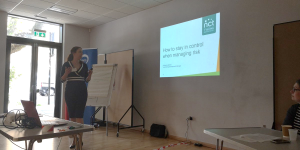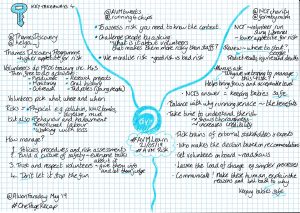What Do Managers of Risk and Managers of Volunteers Have in Common?
Daniel Ingram, Association of Volunteer Managers Director, is delighted to be chairing Inside Government’s upcoming forum Raising Standards of Safeguarding Practice Across the Voluntary Sector. The event is taking place on Thursday 20th June in Central Manchester. Here he discusses the similarities between volunteer managers and those who manage risk.
“Don’t do that” “put that down” “stop bothering your sister” “that’s not food give it to me.”
Just some of the risk management advice I give to my niece Isla, who is three at the turn of the month. Reader, you know what comes next. Like any two year old worth her salt - she does that, she does not put it down, she bothers her brother instead, she investigates whether it is food for herself. She doesn’t go on my word alone.
 Catherine from NCT presenting her session at Risk factor
Catherine from NCT presenting her session at Risk factor
When challenging situations occur with volunteers or in risk management, we can feel like a parent with a child. Why can’t the person involved have behaved more responsibly?
The reaction can be to send out blanket messages saying ‘Do not do this under any circumstance’ or ‘now only one authorised person can do this’. But does this formal unilateral approach prevent avoidable incidents from re-occuring?
I don’t profess to be a risk management expert, but when I went looking for the answer before AVM’s recent event, I spotted something very familiar.
Definition of collaborative risk management
It is only when individuals work closely and in an open fashion i.e. collaboratively, that a joint understanding of the risks for each person involved is gained. It also encourages an open culture between the individuals involved - through building communication and trust.
In this definition, I believe, we have the meeting point for managers of risk and managers of volunteers.
At AVM, we know that risk management is a high priority for leadership teams and the profile it has concerning the third sector, whether it be safeguarding, health and safety or reputational risk. But we also know that formal barriers demotivate people (e.g. volunteers) from taking action.
Our recent Risk factor event explored this subject and came to the conclusion that in order for risk management and volunteering to successfully support each other we need:
- Trust - enabling volunteers to make sensible judgements about risks
- Communication - agreeing a plan and sharing updates when there’s news or no news
- A culture of safety - where everyone has a responsibility to manage risks, whilst not removing the fun and enjoyment of volunteering
- Respect - for the experience, knowledge and skills volunteers can bring to support risk management
- Objectives - showing the impact on the things an organisation prioritises
In short, collaborative risk management. Perhaps managers of risk and managers of volunteers aren’t so different after all.
So how would I approach things with my niece now?
 Sketch note from Alison from British Red Cross, delegate at Risk factor
Sketch note from Alison from British Red Cross, delegate at Risk factor
This advice from renowned psychotherapist Philippa Perry at an RSA event really resonated with me and echoes the collaborative relationship building theme. Unlike saying “you must” or “you’ve got to” – by defining and sharing the emotional impact on someone they care about, your children understand why the boundary is there.
So, when I see Isla on her birthday at the dinosaur park I’ll be ready, if needed, to say:
“Don’t do that…it makes me very scared” “put that down…I am worried” “stop bothering your sister…it is making her sad”.



